Sc235 - Study guides, Class notes & Summaries
Looking for the best study guides, study notes and summaries about Sc235? On this page you'll find 32 study documents about Sc235.
Page 3 out of 32 results
Sort by
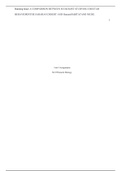
-
SC235 Unit 2 Assignment.docx Unit 2 Assignments SC235General Biology. A Comparison Between Ecologist Studying Cheetah Behavior in the Saharan Desert and Human Habitat and Niche. Habitat is a set of the place of ecological conditions wherein
- Summary • 7 pages • 2021
-
- $5.49
- 1x sold
- + learn more
SC235 Unit 2 A Unit 2 Assignments SC235General Biology. A Comparison Between Ecologist Studying Cheetah Behavior in the Saharan Desert and Human Habitat and Niche. Habitat is a set of the place of ecological conditions wherein specific life form lives and adjust the circumstance likewise. My habitat is a spot with crisp water to wash and drink. Enough palatable plants and organic products. Little creatures to chase, not too many huge creatures to be chased by, spots to avoid the pr...
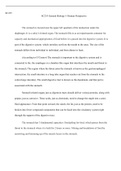
-
SC235 General Biology I Human Perspective.docx SC235 SC235 General Biology I- Human Perspective The stomach is located near the upper left quadrant of the midsection under the diaphragm. It is a solid, J-formed organ. The stomach fills in as an impe
- Summary • 4 pages • 2021
-
- $7.49
- + learn more
SC235 General Biology I Human P SC235 SC235 General Biology I- Human Perspective The stomach is located near the upper left quadrant of the midsection under the diaphragm. It is a solid, J-formed organ. The stomach fills in as an impermanent container for capacity and mechanical appropriation of food before it is passed into the digestive system. It is part of the digestive system. which stretches out from the mouth to the anus. The size of the stomach differs from individual to individual...

-
SC235 unit 4 Assignment.docx Unit 4 Assignments SC235General Biology. SPLEEN My assigned organ for this assignment is spleen. The spleen is the biggest organ in the lymphatic sys
- Summary • 6 pages • 2021
-
- $5.49
- + learn more
SC235 unit 4 A Unit 4 Assignments SC235General Biology. SPLEEN My assigned organ for this assignment is spleen. The spleen is the biggest organ in the lymphatic system(Hirsch, 2019). It is a significant organ for keeping natural liquids adjusted, however, it is conceivable to live without it. The spleen is situated under the ribcage or more the stomach in the left upper quadrant of the mid-region. A spleen is delicate a...
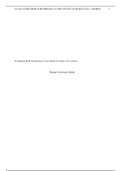
-
SC235 unit Unit 9 Assignment.docx Evaluating Risk for Disease a Case Study of Sickle Cell Anemia Purdue University Global Evaluating Risk for Disease a case study of Sickle cell anemia Family bonds can be extremely solid, so solid that few heredit
- Summary • 5 pages • 2021
-
- $5.49
- + learn more
SC235 unit Unit 9 A Evaluating Risk for Disease a Case Study of Sickle Cell Anemia Purdue University Global Evaluating Risk for Disease a case study of Sickle cell anemia Family bonds can be extremely solid, so solid that few hereditary issues, or conditions, are regular in kids through their folks or grandparents where ailments can straightforwardly be followed back through heritage or ethnicity. For instance, sickle cell anemia deficiency is one normal hereditary issue that for the mos...
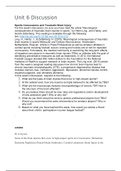
-
SC235 Unit 6 Discussion.docx Unit 6 Discussion Sports Concussions and Traumatic Brain Injury For this weeks discussion, be sure you have read the article "Neurological consequences of traumatic brain injuries in sports, by Helen Ling, John Hardy, a
- Summary • 3 pages • 2021
-
- $5.49
- + learn more
SC235 Unit 6 D Unit 6 Discussion Sports Concussions and Traumatic Brain Injury For this weeks discussion, be sure you have read the article "Neurological consequences of traumatic brain injuries in sports, by Helen Ling, John Hardy, and Henrik Zetterberg. This reading is available through the following link:
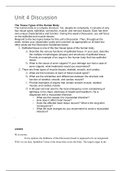
-
SC235 Unit 4 Discussion.docx Unit 4 Discussion The Tissue Types of the Human Body The human body is a complex structure. Yet, despite its complexity, it consists of only four tissue types; epithelial, connective, muscle, and nervous tissues. Each has t
- Summary • 4 pages • 2021
-
- $5.49
- + learn more
SC235 Unit 4 D Unit 4 Discussion The Tissue Types of the Human Body The human body is a complex structure. Yet, despite its complexity, it consists of only four tissue types; epithelial, connective, muscle, and nervous tissues. Each has their own unique characteristics and function. During this weeks Discussion, you will focus on the epithelial and muscle tissues. Respond to the two topics below for this units Discussion. Then, throughout the week, review your classmates posts and comment as...
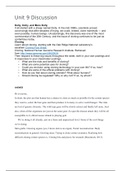
-
SC235 Unit 9 Discussion.docx Unit 9 Discussion Dolly, Dolly, and More Dolly It all started with a sheep named Dolly. In the mid-1990s, scientists proved convincingly that after decades of trying, we could, indeed, clone mammals ” and even possibly, hum
- Summary • 3 pages • 2021
-
- $5.49
- + learn more
SC235 Unit 9 D Unit 9 Discussion Dolly, Dolly, and More Dolly It all started with a sheep named Dolly. In the mid-1990s, scientists proved convincingly that after decades of trying, we could, indeed, clone mammals ” and even possibly, human beings. Unsurprisingly, this discovery was one of the most controversial of the 20th Century, and the issue of cloning continues to be just as contentious today. Cloning Learn about cloning, starting with the Oak Ridge National Laboratory's excellentC...
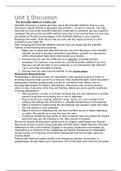
-
SC235 Unit 1 Discussion.docx Unit 1 Discussion The Scientific Method in Daily Life Scientific Discovery is based upon the use of the Scientific Method. This is a very structured, logical method to approach any problem “ not just in science. You may thi
- Summary • 3 pages • 2021
-
- $5.49
- + learn more
SC235 Unit 1 D Unit 1 Discussion The Scientific Method in Daily Life Scientific Discovery is based upon the use of the Scientific Method. This is a very structured, logical method to approach any problem “ not just in science. You may think that the use of the Scientific Method is restricted to scientists, but you would be mistaken! We all use the scientific method every day in our normal lives, but you may not realize it! Review the description of the Scientific Method in your required Rea...
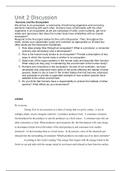
-
SC235 Unit 2 Discussion.docx Unit 2 Discussion Humans and the Ecosystem We all live in an ecosystem; a community of both living organisms and non-living elements interacting with each other. Humans have commonality with the other organisms in an ecosys
- Summary • 3 pages • 2021
-
- $5.49
- + learn more
SC235 Unit 2 D Unit 2 Discussion Humans and the Ecosystem We all live in an ecosystem; a community of both living organisms and non-living elements interacting with each other. Humans have commonality with the other organisms in an ecosystem as we are composed of cells, cycle nutrients, get rid of waste and reproduce. But does the human body have similarities with an overall ecosystem? Respond to the five topics below for this units Discussion. Then, throughout the week, review your classmat...
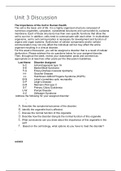
-
SC235 Unit 3 Discussion.docx Unit 3 Discussion The Importance of the Cell in Human Health The cell is the basic unit of life. It is a highly organized structure composed of numerous organelles, cytoplasm, cytoskeletal structures and surrounded by a pla
- Summary • 3 pages • 2021
-
- $5.49
- + learn more
SC235 Unit 3 D Unit 3 Discussion The Importance of the Cell in Human Health The cell is the basic unit of life. It is a highly organized structure composed of numerous organelles, cytoplasm, cytoskeletal structures and surrounded by a plasma membrane. Each of these structures has their own specific functions that allow the cell to survive. In addition, cells need to communicate with each other. In multicellular organisms, cell to cell communication is necessary for development and function of...

Did you know that on average a seller on Stuvia earns $82 per month selling study resources? Hmm, hint, hint. Discover all about earning on Stuvia


